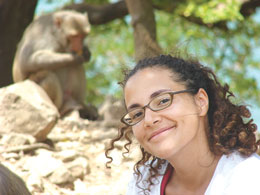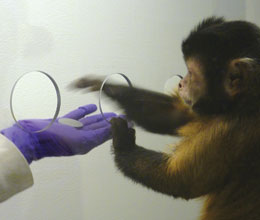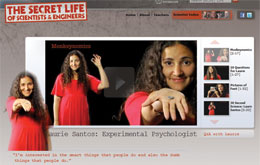Monkey Business

Laurie Santos
Years ago, in the early days of what’s now known as behavioral economics, researchers began to recognize that people often made decisions rational economic theory failed to predict. Many of these decisions were characterized by extremely negative responses to loss. When a person possessed an item, for instance, he demanded far more compensation to part with it than he was willing to pay for something of similar value that belonged to someone else. In 1980 Richard Thaler named this theoretically peculiar behavior the endowment effect.
Over time, the endowment effect held up quite well under scrutiny. In one classic study, Thaler, working with Daniel Kahneman and Jack Knetsch, gave a group of people coffee mugs and then released the participants into a market environment, where they were free to trade — or not trade — with others. While potential buyers offered a median price of $2.25 for the mugs, sellers required around $5.75 to give up their possessions. Contrary to many economic assumptions, the researchers concluded in a 1990 issue of the Journal of Political Economy, the endowment effect and special aversion to loss are “fundamental characteristics of preferences.”
Since then, many psychologists have wondered just how fundamental these preferences are. The question is a critical one, particularly if we hope to correct our irrational behaviors. On one hand, if tendencies like the endowment effect are confined to certain cultures or social settings, then environments could be causing the flawed approach — in which case, simple feedback or experience should improve our financial decisions. On the other hand, if our economic biases are innate rather than learned, more universal than circumstantial — in short, if they’re rooted in basic human cognition — then managing them becomes a much tougher task.
In recent years this question has guided the research of Laurie Santos, who is the director of the Comparative Cognition Laboratory at Yale University. Over the past decade, Santos has run a number of experiments that are similar to those designed by Thaler and colleagues in nearly every respect except one: Instead of testing humans, Santos works with capuchin monkeys. Capuchins broke off the human line roughly 35 million years ago; as a result, they share many of our complicated cognitive strategies, yet they remain isolated from the linguistic, cultural, and technological systems that might corrupt human decision making. From the perspective of someone studying irrational economic biases, the monkeys offer an excellent means of distinguishing learned behaviors from natural ones. They provide, as Santos says, a “really great window” into human behavior of old. In study after study in recent years, that window has shown Santos and her collaborators that capuchins indeed repeat many of the economic mistakes once considered unique to mankind — from loss aversion to the endowment effect to certain risk behaviors — suggesting that these irrational tendencies are a long-held, fundamental phenomenon.
“When you study humans it’s hard to get to the root of what makes us who we are,” says Santos, who will participate in the Presidential Symposium at the APS Annual Convention in May. “If you look at the field of psychology over the last 20 years, you don’t find that humans are so smart. You find that our judgments are bad and that we’re biased and prejudiced — things we’re not really proud of, and that can seem pretty irrational. I realized there was no study of the origin of this stuff — no idea where the biases came from. I took that to be a bit of a puzzle.”
 The first step toward solving this puzzle began in the early 2000s. Before Santos and Yale colleagues Keith Chen and Venkat Lakshminarayanan could test for irrational economic behavior in capuchin monkeys, they had to be sure the monkeys understood the concept of money at all. So the researchers designed a special “monkey marketplace,” a separate cage accessible from the normal monkey living space, complete with open slots that enabled the animals to interact with experimenters. Then they issued the monkeys “wallets” filled with small, coin-like tokens. Finally they had two experimenters pose as traders, offering food through the slots in exchange for tokens.
The first step toward solving this puzzle began in the early 2000s. Before Santos and Yale colleagues Keith Chen and Venkat Lakshminarayanan could test for irrational economic behavior in capuchin monkeys, they had to be sure the monkeys understood the concept of money at all. So the researchers designed a special “monkey marketplace,” a separate cage accessible from the normal monkey living space, complete with open slots that enabled the animals to interact with experimenters. Then they issued the monkeys “wallets” filled with small, coin-like tokens. Finally they had two experimenters pose as traders, offering food through the slots in exchange for tokens.
As it turns out, the monkeys quickly mastered the rules of basic exchange. They learned to deposit a token into the outstretched hand of one trader and receive the piece of food being offered by the other hand. They learned to recognize a sale, purchasing more apples when the price dropped. In fact, Santos told an audience at a TED conference last July, it didn’t take long for the monkeys to reflect many of the same negative behaviors humans exhibit in the presence of money: Some stole tokens from their neighbors, and others, evidently averse to saving, spent their entire allowance in a flash.
With this initial understanding of markets in place, Santos, Chen, and Lakshminarayanan moved on to more complex financial interactions. One of their first experiments looked for evidence of a tendency known as reference dependence. The idea behind this behavior is that people prefer to gamble when the outcome is framed as a bonus than when it’s framed as a loss, even when the payoffs for either outcome are identical.
To test for this bias in capuchins, the researchers positioned two types of traders in the monkey marketplace. One trader always offered two pieces of apple — for clarity’s sake, we’ll call him Larry Loss, though the researchers used no such name. Upon receiving a token, sometimes Larry Loss handed two pieces to the monkey, but sometimes he removed one and delivered only a single piece. A second trader — let’s say Bonus Bob — always offered one piece of apple. When given a token, Bonus Bob sometimes delivered the single piece and sometimes added a second, extra piece. Sure enough, the monkeys preferred to trade with Bonus Bob, approaching him 71 percent of the time.
On the heels of this finding, Santos and collaborators studied a related behavior called loss aversion. Generally speaking, this concept states that people will go to great lengths to avoid losses, which have a stronger psychological effect on them than gains. To test loss aversion, the researchers brought back Larry Loss and paired him with a new trader, Even Stephen. Once again, Larry Loss offered two apple pieces. When the monkeys paid him a token, however, he delivered only one piece every time. Even Stephen, on the other hand, consistently showed one piece and, once paid, delivered the piece as promised.
Although the payoffs were identical in the end — both traders always parted with one piece of apple — the monkeys disliked the disappointment associated with Larry Loss. As a result, they traded with Even Stephen 79 percent of the time. Put together, the findings suggest that hallmark biases like reference dependence and loss aversion extend “beyond humans and may be innate rather than learned,” the authors concluded in a 2006 issue of Journal of Political Economy.
For their second act, Santos and the same collaborators took aim at the endowment effect — “the next natural thing to test,” she says. To demonstrate beyond a doubt that capuchins suffered from an endowment effect, the researchers put the monkeys through a rigorous series of four experiments, each designed to eliminate alternative explanations for the irrational economic behavior.
In the first test, Santos and colleagues found that monkeys in possession of one food were hesitant to trade for another — even though previous trials had established that monkeys enjoyed both foods equally. When the monkeys possessed a fruit disc, for instance, they traded it for a cereal clump less than 2 percent of the time; when they began with cereal, their rate of exchange still reached only 15 percent. Both figures fell far below the 50 percent rate one would expect for two similarly desirable items. In a second test, the researchers found that monkeys readily exchanged both fruit discs and cereal clumps for a highly esteemed marshmallow fluff at rates of 93 and 82 percent, respectively. This told Santos and company that the monkeys weren’t simply reluctant to trade in general.
With these trials down, another possibility loomed: Perhaps trading, a more active endeavor than simply eating, isn’t worth the added effort. So in a third experiment the researchers provided monkeys with an incentive to trade in the form of an extra oat given after each exchange — a capuchin transaction fee, of sorts. Still, the monkeys gave up fruit discs only 5 percent of the time and cereal around 22 percent of the time. Finally, the researchers gave the monkeys an almond in its shell and offered them the chance to trade for another almond that was already shelled. Still, the monkeys seemed to prize their new possession, trading the unshelled nut only a quarter of the time, even though making the exchange would have led to quicker consumption.
The results were clear: across a variety of situations, monkeys valued their own personal items more highly than those possessed by someone else. Simply put, the endowment effect “is not unique to humans,” the authors concluded in a 2008 issue of Philosophical Transactions of the Royal Society B. The results provided further evidence that “our human systematic biases might be the result of evolved cognitive strategies.”
In her latest work, also conducted with Chen and Lakshminarayanan, Santos found evidence for a reflection effect in monkeys. The idea here is that our aversion to loss is such that we’re willing to engage in risky transactions just to avoid it; on the flip side, we feel no reason to take risks in the face of gains. This conduct is particularly noticeable among stock traders, says Santos, who have been known to sell assets that perform well and hold those that have declined in value — enabling them to recognize gains and ignore losses (in the financial world, this behavior is known as the disposition effect).
To test for this behavior in capuchins, Santos and colleagues brought two types of traders into the monkey marketplace. The first offered a sure loss; he presented three pieces of apple and always handed over two. The second represented a risky loss; he also showed three pieces, but sometimes he delivered all three and other times he gave up just one. The results would make stock traders proud: The monkeys were so willing to avoid loss that they preferred the risky dealer 71 percent of the time, the researchers report in a paper in press at the Journal of Experimental Social Psychology. The researchers confirmed the reverse tendency as well — finding that monkeys prefer safe gains to risky gains — suggesting that capuchins do, in fact, display the full reflection effect.
The body of research compiled by Santos and her colleagues represents considerable evidence that irrational economic tendencies are not learned but rather built into our cognitive architecture. It also begs a considerable question: Why did evolution select for behaviors that seem so irrational today? The simplest explanation has to do with head size, says Santos. A human brain capable of performing an immediate, exhaustive economic analysis of every situation would require a brain too large to fit inside a reasonably sized skull. Another possibility is that biases like the endowment effect were highly adaptive in pre-linguistic, lawless environments.
 “In modern Western societies, if someone fails to keep up their end of the bargain, we engage the police and the legal system,” says psychologist Sarah Brosnan of Georgia State University, who has found evidence of the endowment effect in apes. “That isn’t possible for non-verbal species. Thus it was likely almost always more advantageous for individuals to hold on to what they had than to take a chance for something better.”
“In modern Western societies, if someone fails to keep up their end of the bargain, we engage the police and the legal system,” says psychologist Sarah Brosnan of Georgia State University, who has found evidence of the endowment effect in apes. “That isn’t possible for non-verbal species. Thus it was likely almost always more advantageous for individuals to hold on to what they had than to take a chance for something better.”
Whatever the reason for our irrational economic tendencies, knowing that they’re largely biological can guide efforts to correct them. An approach that seems particularly useful considering the monkey research is that of behavioral nudging, says Santos. This effort, crafted by none other than Richard Thaler gently steers people away from erroneous — and, it appears, instinctive — financial decisions by redesigning situations with these tendencies in mind. (Thaler’s most famous program, Save More Tomorrow, encourages employees to contribute to their company retirement fund simply by changing the default setting from opt-in to opt-out.)
Santos believes that the practical implications of her work is a major reason why economists have taken to it. “I think this question resonates with them: Where do these biases come from? Learning that these things might be inherent suggests totally different policies for dealing with them. … The approach is, let’s assume these biases are stable and will be there and will affect choice, so you design policies around them.”





Comments
really wonderful study done to trace roots of our irrational economic decisions
i thought this behaviour is vestige or remnant of the past. the era in which food was no gaurantee. the day began with searching for food and wasn’t surplus wasn’t stored for tomorrow
as these experiments are concerning with food items that tendency for loss aversion, endowment is seen, and probably nothing to do with lawlessness or the complex economic calculations or the brain size
APS regularly opens certain online articles for discussion on our website. Effective February 2021, you must be a logged-in APS member to post comments. By posting a comment, you agree to our Community Guidelines and the display of your profile information, including your name and affiliation. Any opinions, findings, conclusions, or recommendations present in article comments are those of the writers and do not necessarily reflect the views of APS or the article’s author. For more information, please see our Community Guidelines.
Please login with your APS account to comment.